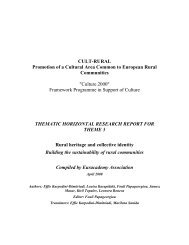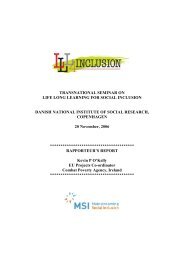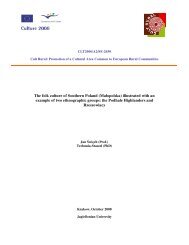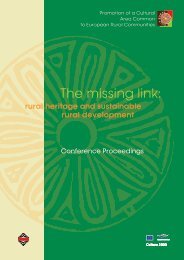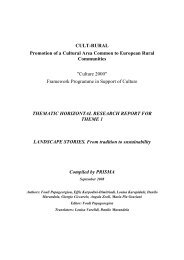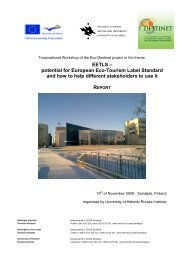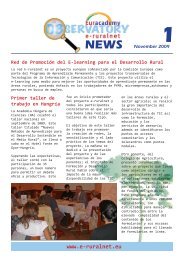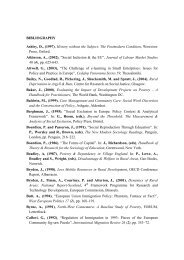ÐÐ¾Ð´Ð°Ñ Ð¿Ð¾ изложбаÑа - cult rural - Prisma
ÐÐ¾Ð´Ð°Ñ Ð¿Ð¾ изложбаÑа - cult rural - Prisma
ÐÐ¾Ð´Ð°Ñ Ð¿Ð¾ изложбаÑа - cult rural - Prisma
You also want an ePaper? Increase the reach of your titles
YUMPU automatically turns print PDFs into web optimized ePapers that Google loves.
HISTORICAL AND CULTURAL BACKGROUND<br />
4<br />
Rural customs and events play a leading role in the <strong>cult</strong>ure of the three countries<br />
participating in the current exhibition. They keep the collective memory alive and<br />
manifest, in the most eloquent way, the strong foundation and the values of each<br />
community upon which it’s social and <strong>cult</strong>ural evolution has been built.<br />
Greece, at the South end of the Balkan Peninsula in the crossroads between<br />
Europe and the East, has one of the most long standing <strong>cult</strong>ural traditions due to<br />
historical and geographical reasons. Both East and West exercised influences<br />
on Greek <strong>cult</strong>ure, while great civilisations have left their impact through the<br />
ages all over its geographic extent. Rural areas, especially those of the North<br />
(Epirus, Macedonia and Thrace) were the ones that largely contributed to the<br />
<strong>cult</strong>ural evolution. Living in the same geographical area for centuries, speaking<br />
a language that has naturally evolved from antiquity, Greeks continue, mostly<br />
in the <strong>rural</strong> communities, their traditional customs and rites. Rituals dating back<br />
to antiquity, signs and symbols expressed on different occasions, especially<br />
during festive events combining Christian and pre-Christian elements, depict the<br />
multifaceted and multilevel <strong>cult</strong>ural identity of the <strong>rural</strong> areas. A plurality of mutually<br />
interdependent signs and symbols guide and regulate the social practices of every<br />
day life. Consciously or unconsciously reproduced, they provide a <strong>cult</strong>ural code<br />
that manifests itself on various occasions. The objects and photos of the current<br />
exhibition offer some illustrative examples<br />
Poland, situated in Central Europe, has a <strong>cult</strong>ure closely related to the country’s<br />
long history. Customs, rites and rituals, feasts and festivals reflect the unique<br />
character of the country, as well as all the influences and inspirations exercised<br />
5. Musicians lead the parade<br />
during Epiphany in Kali Vrysi,<br />
Macedonia, Greece. (phot.<br />
V.Voutsas)<br />
6. Carol-singer, Bulgaria<br />
5.<br />
on Polish <strong>cult</strong>ure and so contributing to Poland’s <strong>cult</strong>ural identity. Małopolska,<br />
situated in the south-eastern part the country, constitutes a unique centre of the<br />
Polish Carpathians, not only in the geographical sense, but also the <strong>cult</strong>ural one.<br />
Malopolska is one of the oldest (10th c.) and the most important regions of Poland.<br />
The main centre of the area, Cracow, was the capital of the country until the end of<br />
the 16th c.. During the time of the annexation (1772-1918) Małopolska, which was<br />
under the rule of Austria (the so-called Galicia), played a remarkable role in the<br />
reconstruction of the Polish state regained after the 1st World War.<br />
The folk <strong>cult</strong>ure of Małopolska was shaped in the result of many centuries’ lasting<br />
settlement processes. The main role was played by Polish people; besides them<br />
there were Jews, Germans and, in the southern-eastern part, Ukrainians. In the<br />
territory of Małopolska the majority were mainly Polish ethnographic groups,<br />
numerous groups of highlanders (for example from Podhale), Lasowiacy and<br />
Rzeszowiacy. In the territory of Małopolska a lot of traditional rites and folk customs<br />
remain today. The region where the folklore is most evident is Podhale.<br />
Bulgaria, located in Southeastern Europe, preserves traditions dating back many<br />
centuries. Bulgaria adopted Christianity in the 9th century. During the Middle<br />
Ages its <strong>cult</strong>ure bridged the civilizations of Antiquity and Byzantium with that of<br />
the Slavonic world as Bulgarian became the first literary, liturgical and officialadministrative<br />
Slavonic language. Under Ottoman rule, Bulgarian <strong>cult</strong>ure in<br />
common with the other Balkan <strong>cult</strong>ures, created a compensatory rich folklore and<br />
multiform ethnographic <strong>cult</strong>ure. The history of the Bulgarian <strong>rural</strong> spiritual <strong>cult</strong>ure<br />
supplies abundant materials for exhibitions, scientific seminars and summer<br />
schools, for detailed research on that <strong>cult</strong>ure, as well as for various initiatives in<br />
which this particular problematic can be popularized among young people. The two<br />
scientific institutions participating in the current exhibition (the National Museum<br />
of History and the Academy for Balkan Civilizations) explore the dynamic changes<br />
that have taken shape in the traditional <strong>rural</strong> <strong>cult</strong>ure as a result of industrialization<br />
and globalization. They also draw attention to those features of contemporary <strong>rural</strong><br />
<strong>cult</strong>ure which would, to the greatest degree, guarantee the sustained development<br />
both of <strong>cult</strong>ure and of certain important aspects of life of the young generation in<br />
<strong>rural</strong> regions, their social integration and <strong>cult</strong>ural identity.




